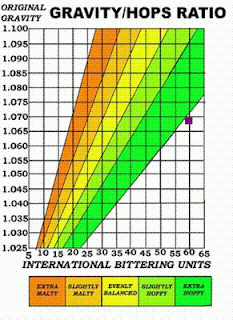My spin on a typical American Wheat beer. I've added a touch of Rye malt for some spice (hopefully).
This is the first time I've performed a step mash. It was somewhat difficult given my low tech setup. Infusing hot water to the thick mash was a real crap shoot but it worked... more or less. I decided to use a Beta Glucan and Protein rest to assist with lautering. I suppose I could have just gone with a single infusion and some rice hulls but what's the fun in that!
American Wheat or Rye Beer (6D)
Recipe Type: All Grain
Yeast: Fermentis Safale S-04
Yeast Starter: Nope
Additional Yeast : Nope
Batch Size (Post Boil): 26L
Original Gravity: 1.050
Final Gravity: 1.012 (est)
IBU: 24
Boiling Time (Minutes): 65
Colour (SRM): 3.5 (est)
Primary Fermentation (# of Days & Temp): 10 @ 68F
Secondary Fermentation (# of Days & Temp): N/A
Conditioning [Bottle] (# of Days & Temp): 21 @ 68F
Ingredients
Yeast: Fermentis Safale S-04
Yeast Starter: Nope
Additional Yeast : Nope
Batch Size (Post Boil): 26L
Original Gravity: 1.050
Final Gravity: 1.012 (est)
IBU: 24
Boiling Time (Minutes): 65
Colour (SRM): 3.5 (est)
Primary Fermentation (# of Days & Temp): 10 @ 68F
Secondary Fermentation (# of Days & Temp): N/A
Conditioning [Bottle] (# of Days & Temp): 21 @ 68F
60.0% Canadian 2-Row (OiO)
30.0% Canadian Malted Wheat (OiO)
10.0% Rye Malt (Weyermann)
30.0% Canadian Malted Wheat (OiO)
10.0% Rye Malt (Weyermann)
24.0 IBU Warrior (16g @ 60 min)
Water (City tap water treated with Campden)
Acid Malt, Gypsum, Calcium Chloride and Epsom Salt added, pH 5.50
Mash Instructions
Step Mash, 20 minutes (110F), 1qt/lb - Thick Mash
Infuse hot water and bring mash to conversion temp, 60 minutes (150F)
Double batch sparge (170F), collected ~30L into the boil kettle
*** Update June 12, 2012***
10 days since pitching a fresh packet of S-04, hydro sample reads 1.016. If complete, that's definitely on the low end of the yeasts projected attenuation (70.4%). Will measure a second time later in the week and if it reads the same, into the bottle. Sample was pleasant albeit slightly sweeter than desired. I mashed low (150F) so I am surprised I didn't get a more fermentable beer? Perhaps something to do with my stepped mash? Oh well, live and learn I suppose, beer still tastes great! Will go single infusion with rice hulls next time.
Ca-74/Mg-14/Na-18/Cl-97/S04-107
Mash Instructions
Step Mash, 20 minutes (110F), 1qt/lb - Thick Mash
Infuse hot water and bring mash to conversion temp, 60 minutes (150F)
Double batch sparge (170F), collected ~30L into the boil kettle
*** Update June 12, 2012***
10 days since pitching a fresh packet of S-04, hydro sample reads 1.016. If complete, that's definitely on the low end of the yeasts projected attenuation (70.4%). Will measure a second time later in the week and if it reads the same, into the bottle. Sample was pleasant albeit slightly sweeter than desired. I mashed low (150F) so I am surprised I didn't get a more fermentable beer? Perhaps something to do with my stepped mash? Oh well, live and learn I suppose, beer still tastes great! Will go single infusion with rice hulls next time.







